The Trump Administration Is Courting Ecological Disaster in Alaska
Izembek National Wildlife Refuge has been protected for decades. Now it's being opened to development, with potentially dire consequences.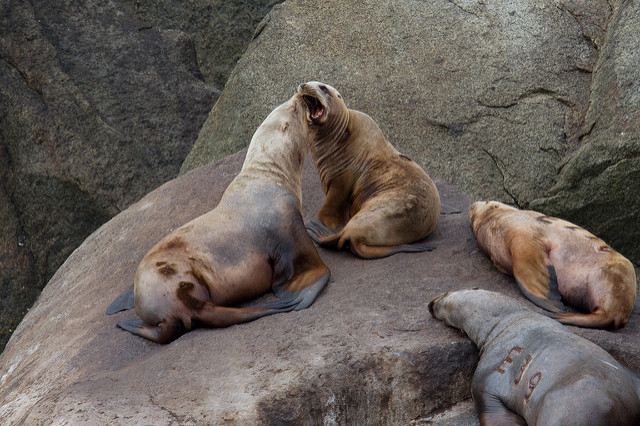 Marcel Holyoak / Flickr
Marcel Holyoak / Flickr
COLD BAY, Alaska – At the spot where a rugged chain of islands breaks away from the Alaska Peninsula, a secluded national refuge protects millions of seabirds, grizzly bears and caribou.
Framed by snow-capped mountains and smoky volcanoes, the refuge holds an irreplaceable underwater grass forest, where the world’s population of a tuxedo-colored sea goose – 150,000 of them – fattens up before a nonstop 60-hour migration to Mexico.
For six decades, the Izembek National Wildlife Refuge, tucked along the coast of the Bering Sea, has been protected as one of the wildest nature spots on Earth, remote enough to escape development.
But that isolation has been shattered. Seven noisy helicopters swooped down 80 times over two days in July to land on the narrow isthmus where animals nest, feed and migrate.
Then-Interior Secretary Ryan Zinke, prodded by President Donald Trump, ordered the surprise helicopter survey to prepare to bulldoze a 12-mile road through the refuge’s federally protected wilderness.
Almost a year ago, on a day that the federal government was briefly shut down, Zinke quietly signed a land swap, evading Congress, which has wrestled with the issue for decades. The Interior Department is trading the swath of Izembek’s wilderness to Aleut Natives so their cannery town of King Cove can build the final 12 miles of a 37-mile gravel road to the Cold Bay Airport. In exchange, the federal government gets an equal amount of Aleut land.
In crafting the deal, Zinke rejected the warnings of his department’s scientists. After a four-year study, the U.S. Fish and Wildlife Service, which oversees the refuge, concluded that allowing a road through the refuge would “lead to significant degradation of irreplaceable ecological resources.” It also would jeopardize the global survival of a migratory sea goose, called the Pacific black brant, as well as the emperor goose and other waterfowl, the agency said.
Trump and Zinke have worked behind the scenes to deliver the road to the rural Aleut government of King Cove, which has spent almost 50 years lobbying Congress and the Interior Department. The Aleut say the road is essential to transport patients with medical emergencies to the Cold Bay Airport, where they could then fly to an Anchorage hospital.
Zinke, who left office last week amid multiple ethics investigations, billed his action as allowing a “lifesaving road” for the roughly 1,000 residents of King Cove.
But a close examination of the agreement and the history of the road deal suggests that it is more about selling seafood than saving lives.
A document dating back two decades shows that hauling fish, not patients, was the Aleuts’ original motive for building a road through the national refuge. When that strategy failed, they and Alaska Republican leaders switched to focus on medical necessity.
Now the new land swap deal includes a little-known provision forged by the Interior Department that would allow King Cove fishermen to transport tens of millions of dollars of salmon, crab, cod and other seafood on their way to lucrative Asian markets.
The economy of King Cove is almost totally dependent on commercial fishing. It’s home to the Peter Pan Seafoods cannery, owned by the world’s largest fish processor, Maruha Nichiro Corp. of Japan.
Under the agreement signed by Zinke, the road will be “generally for noncommercial purposes.” But the deal also contains this provision: “The commercial transport of fish and seafood products, except by an individual or a small business, on any portion of the Road shall be prohibited.”
The term “small business” can leave the wrong impression, though. A fishing business is defined as small when it has annual revenue no higher than $20.5 million for finfish, $5.5 million for shellfish or $7.5 million for other marine fish, according to federal codes.
The wording would prevent giant Peter Pan Seafoods, which reports about $225 million in annual sales, from driving fresh seafood to the airport to fly it to Asia and elsewhere. But King Cove’s commercial fishermen – including all of its Aleut leaders – would qualify under those income restrictions to use the road for transporting their fish and seafood, according to state data on seafood earnings. And Peter Pan could use it to transport its workers, up to 500 in peak salmon season.
Zinke and Aleut leaders never mentioned or explained the loophole when discussing the land swap in public.
The provision “could easily be exploited” for business purposes, said Deborah Williams, a former Interior Department attorney. The agreement between Zinke and King Cove “could – but does not – restrict the use of the road to health and safety issues,” she said.
A road would disturb more than just its immediate path. It would bring traffic and noise and give King Cove subsistence hunters and visitors easy access to animals in dense, undisturbed parts of the wilderness. It also would bisect the land bridge for bear and caribou, which are sensitive to disturbance, according to wildlife biologists.
The deal will decimate the “most important wildlife refuge in all of Alaska,” said Bruce Babbitt, who rejected the road when he served as interior secretary during the Clinton administration. “Izembek is a convergent point where seabirds migrating out of the Arctic feed. If that link is broken, we’re at risk of extinction of all those bird species.”
Leaders in King Cove say road opponents are valuing birds and other wildlife more than residents’ medical needs. Lillian Sager is a member of the large Aleut commercial fishing family that has tried to get the road built for decades.
“When I’m stuck in King Cove and the wind is blowing 100 miles an hour and I’m sick, you want to get out of that town. All that is more important than if there is garbage on the road or if (hunters) are going to shoot animals,” said Sager, whose brother is King Cove Mayor Henry Mack.
However, a medical expert disputes that a road through the refuge is a safe way to transport patients. And a federal report has outlined other reliable alternatives.
A doctor who oversaw medical evacuations in King Cove for 15 years said traveling almost 40 miles on the gravel road during 60 mph winds and blinding snowstorms would be “suicidal” for patients and rescue teams.
“Should the road happen, I foresee all sorts of calamity,” said Dr. Peter Mjos, who was the Eastern Aleutian Tribes’ medical director until 2002. He retired from practicing medicine in 2015.
The road is the centerpiece of a campaign by Trump and Alaska’s Republican congressional delegation to monetize the state’s public lands by approving private development, oil drilling, mining and logging.
Also on Trump’s wish list are oil exploration in the Arctic National Wildlife Refuge, offshore drilling in the Arctic Ocean, logging in the Tongass National Forest and two mines, one in Bristol Bay and one in mountains west of Fairbanks.
Trump personally promised Alaska Sen. Lisa Murkowski that he’d get the road built. He scribbled a note to her on a copy of an Oct. 16, 2017, Washington Post story about the land swap.
“Lisa – We will get it done,” Trump wrote in a note Murkowski shared at a press conference.
Eight months later, a month before the helicopter land survey, Trump asked her, “How’s our beautiful little road doing in Alaska?”
Messaging Behind the Road Shifts
King Cove’s harbors are filled with fishing vessels, battered from weeks at sea. Like their ancestors for the past 9,000 years, the Aleut depend on the ocean for their food, livelihood and transportation. The town is relatively well off – its median income of almost $73,000 is about 23 percent higher than the national median, though 1 out of every 7 residents lives in poverty.
In these remote parts of Alaska, villages are isolated; roads connecting them are rare. Many of King Cove’s Aleut are prosperous commercial fishing families with cars and trucks but few roads on which to drive.
Currently, people who need more care than a medical clinic can provide are evacuated to the Cold Bay Airport by helicopter or small plane, then flown to Anchorage. Such air transport, however, is hampered by high winds. On average, one or two patients are evacuated from King Cove per month.
Mjos, the retired doctor in King Cove, called the road “a folly.” The area has the highest average wind speeds of anywhere in the United States, and in winter, the road could be buried under several feet of snow and ice. He said it would be safer to transport patients across the bay by ferry.
The federal Army Corps of Engineers, which reviewed marine options for transporting patients, determined in 2015 that the cheapest, most effective solution would be to provide a terminal and ferry in King Cove capable of withstanding waves and ice, along with an improved Cold Bay dock, at an estimated capital cost of $30 million.
More than 30 other rural communities in Alaska that do not have roads use ferries, according to the report. In comparison, building the road would cost the state the same, an estimated $30 million, with unknown annual maintenance costs.
In 1994, King Cove passed a resolution saying the road would “link together two communities having one of the State’s premier fishing ports/harbors (including North America’s largest salmon cannery) in King Cove with one of the State’s premier airports at Cold Bay.”
There was not a single mention of the road being needed to transport sick or injured people.
About 20 years ago, that messaging changed.
According to a review of their public stances, Alaska politicians and the Aleutians East Borough and city of King Cove dropped references to commercial fishing and Peter Pan Seafoods and switched their focus to health and safety in their efforts to secure the road.
Rarely in recent years have Alaska politicians deviated from their public health message. However, in a 2011 visit, Murkowski, the senator, called the road a “critical ingredient in (our) thriving economic future.” And in May, then-Gov. Bill Walker reported to the Trump administration that it is for “enabling access to health services and movement of goods and people.”
Commercial uses “have always been the main reasons for the road,” said Deborah Williams, the former Interior Department attorney who is now a lecturer on public lands at the University of California, Santa Barbara. When she visited King Cove in the mid-1990s, “they told me, ‘We want that road to take fresh fish to Cold Bay to maximize the value of our fish.’ ”
President Barack Obama’s interior secretary, Sally Jewell, recalled that on a 2013 tour, she repeatedly asked King Cove leaders why they had extended the road right up to the wilderness, leading to nowhere.
“I was finally told, ‘Because we wanted to put pressure on you to build the road through the refuge.’ They actually said that,” she said.
Months later, she rejected the road, citing scientists’ concerns about the impacts on wildlife and concluding that “reasonable and viable transportation alternatives exist.”
Documents show that the local leaders pushing for the road own commercial fishing boats. The Mack family has 25 vessels, one of the largest fleets in King Cove. Five of the six members of the City Council own commercial vessels, and the sixth is in the Mack family.
Dean Gould, who is president of King Cove’s Aleut government and whose name is on the land agreement with Zinke, said he owns a 49-foot vessel; his large family owns seven other commercial fishing boats. Gould said he personally would not use the road to transport his salmon and other fish because he now delivers it to Peter Pan by tender, a vessel that services his boat while he’s at sea for weeks at a time.
So why was the small business provision put in the agreement? Gould said it’s because it “leaves a little bit of door open” if someone hauls “a couple cases … or a pound or two” or if anyone wants to commercially transport fish in the future.
Peter Pan Seafoods, which has been publicly silent on the road project, declined to comment. Henry Mack, the mayor, said the land swap is “still in the court, and I won’t be making a comment on anything to do with the road or commercial fishing.”
Little information has been released about the physical challenges, safety issues and costs that the state and Aleuts would face building and maintaining the road.
“Today, the road costs, maintenance, reliability due to avalanches and storms, and travel time under these conditions are remaining questions that have yet to be given to the public,” said Tony Knowles, Alaska’s governor from 1994 to 2002.
David Bernhardt, who is now Trump’s acting interior secretary, worked with King Cove to arrange the land swap. Shortly after he was confirmed as the department’s second in command in July 2017, Bernhardt held a video meeting with a King Cove group, before the idea became public, according to his calendar record. Bernhardt previously was a lobbyist for the state of Alaska and the oil industry in efforts to open up the Arctic National Wildlife Refuge to oil development.
‘Extraordinary wildlife and wilderness’
Overhead on a September day at the Izembek refuge, clouds of Pacific black brant are flying in by the tens of thousands from the Yukon Delta, Canadian Arctic and eastern Russia. They feed in North America’s largest eelgrass bed, the first to be designated as internationally critical to wildlife.
Nearly the entire emperor goose population and thousands of threatened Steller’s eiders also forage in the eelgrass at Izembek Lagoon. Tributaries run rife with salmon and host grizzly bears. Sea otters in the lagoon pop up with pups on their bellies. On the spits of land that form the estuary’s gate to the sea, hundreds of walruses and harbor seals grunt, roll and rest.
The existing 17-mile stretch of road ends right at the refuge’s wilderness boundary. It’s from this spot that Zinke’s deal would push another 12 miles through the wilderness to the airport.
The U.S. Fish and Wildlife Service concluded that “extraordinary wildlife and wilderness resources … recognized for their national and international significance” would be harmed and that the swapped land “would not compensate for the adverse effects.” The road poses major risks to the survival of brant, tundra swan, emperor goose, bear, caribou and fish populations and moderate risks to many others, according to the agency’s data.
Brant travel almost 3,000 miles every spring and fall to feed on the refuge’s eelgrass. They are elegant-looking birds, mostly jet black with bands of bright white, somewhat like a tuxedo. Small for a goose, they must stay strong to survive their nonstop transcontinental journey.
Their survival rate already is dropping, largely due to degraded winter habitat in Mexico and California. And global warming is altering their behavior, which makes the refuge’s role in protecting them even more critical because they are spending more time there. About one-third of the 150,000 arriving at Izembek now stay for the winter, increasing every year by about 7 percent, according to research.
“Any threats to the Alaska wintering population have implications for the entire Pacific Flyway population,” the 2009 study says, adding that “this species is experiencing a long-term decline and is of conservation concern across its range.”
Christian Dau, a now-retired Fish and Wildlife Service biologist who was based at the refuge in the 1980s and ’90s and co-wrote the paper, said the road would shatter the remoteness that protects the birds.
“I go back to the farsighted founding fathers of the refuge. They always took the conservative approach,” he said. “When your options are narrow, you should act conservatively. You don’t open the floodgates and allow lots of development. In 20/20 hindsight, you might look back and say we made a mistake.”
A few hundred miles to the north, in the Yukon-Kuskokwim Delta, where the brant breed and nest, Myron P. Naneng Sr. is a Yup’ik lifelong subsistence hunter and former president of a Native association of leaders representing 56 villages.
Beginning 35 years ago, the Yup’ik, Aleut and other Alaska Natives agreed to protect geese from subsistence hunting so they could recover from low numbers.
“Building a damaging road now, right through some of the most important and sensitive habitat for brant and emperor geese, would be contrary to the years of conservation work,” Naneng said at a hearing before a House subcommittee in 2017.
“All of us contend with weather delays, expensive travel and long trips to the city for medical care. … But it is not realistic to build roads to all of the Alaska communities,” he added.
The land deal with Zinke is not yet final, pending completion of the surveying and an appraisal. Nine environmental groups have filed suit to stop it.
A battle over its legality centers on two laws: the National Environmental Policy Act and Alaska National Interest Lands Conservation Act. The laws require a study of projects’ environmental effects and consideration of alternatives.
The environmental groups allege that the swap of refuge land is illegal because it does not have conservation purposes and needs a full review and congressional approval. The Trump administration argues that the Alaska act exempts conveying land to Native communities and that provisions don’t apply because it already traded away the land and, therefore, the road would not be built in officially designated wilderness.
A Company Town
It’s a Sunday morning in September in King Cove, and the Peter Pan Seafoods plant is operating 24 hours a day. Some 300 workers are packing pollock for fish sticks, Pacific cod and crab for restaurants and black cod for the most fortunate. In summer sockeye season, the workforce reaches 500 in one of North America’s biggest salmon canneries, which sells salmon under the labels Deming’s or Double “Q.”
Commercial fishing boats – as small as 30 feet and as big as 300 feet – operating in the Bering Sea and Gulf of Alaska are pulling up to the plant with their fresh catch. The fish and shellfish are processed and sent frozen atop 400-foot barges to markets in the Lower 48, Europe and Asia. The previous day, Peter Pan processed 800,000 pounds of seafood.
Wearing hairnets, smocks and earplugs, the workers tend to conveyor belts, freezer rooms and chopping tables. They sleep in dormitories in King Cove. Their long shifts, minimum-wage jobs and foreign languages separate them from the town’s more comfortable residents in fishing families.
On this Sunday morning, Irene “Koochie” Christiansen, 83, is carefully making her way from her home near the cannery to the Russian Orthodox church, where she gives weekly readings. As she lights candles, her soft prayers in Aleut and English fill the church adorned with icons and bells from another church in the nearby village of Belkofski, where she grew up.
In the Aleut way, she invites some visitors back to her place for flaky salmon pie. Christiansen grew up trapping animals in Belkofski, which was settled by Russian fur traders. She worked 16-hour shifts at the cannery and is grateful for the wages that paid for her cozy house and the help she gets from prosperous Aleut fishing families.
Christiansen said that if she had a medical emergency, she wouldn’t want to travel over a winding 37-mile, windswept route. Only a respected elder such as Christiansen, one of only two in King Cove who speak Aleut, would feel confident speaking out against the road so popular with King Cove’s fishing families and political leaders.
One day, her son Cal took her berry-picking on the road that now ends at the refuge’s wilderness boundary. The road makes no sense to her.
“Let’s go home,” she told her son.
Your support is crucial…With an uncertain future and a new administration casting doubt on press freedoms, the danger is clear: The truth is at risk.
Now is the time to give. Your tax-deductible support allows us to dig deeper, delivering fearless investigative reporting and analysis that exposes what’s really happening — without compromise.
Stand with our courageous journalists. Donate today to protect a free press, uphold democracy and unearth untold stories.
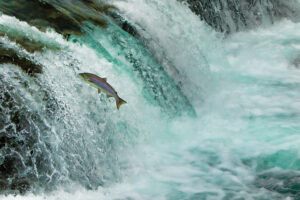
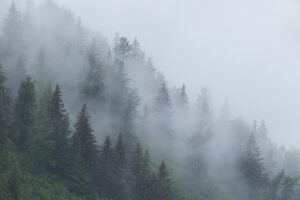
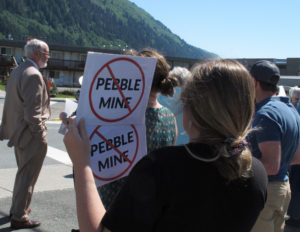

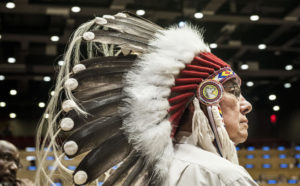

You need to be a supporter to comment.
There are currently no responses to this article.
Be the first to respond.